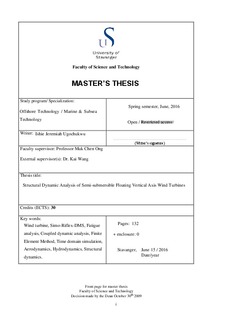| dc.description.abstract | The risk, price inconsistency and environmental impact associated with oil and gas exploration and production have geared a focus on renewable energy. Wind power, the fastest growing source of renewable power generation in Europe, is a major competitor to oil and gas. The strong and stable wind at offshore locations and the increasing demand for energy have surged the application of wind turbines in deep water. Wind turbines are categorized into Horizontal Axis Wind Turbines (HAWTs) and Vertical Axis Wind Turbines (VAWTs) based on their respective orientation of axis of rotation. A floating wind turbine will experience large loads from wind, waves and rotating blades. Research has focused on the design, structural integrity, platform motion and installation of floating horizontal-axis wind turbines (FHAWTs) to better understand the performance of different concepts and to provide the basis for detailed structural design. However, the application of floating vertical axis wind turbines (FVAWTs) in deep offshore has potentials due to its economic advantage in installation and maintenance.
Research in the development of FVAWTs is still green. However, a variety of studies applied different simulation tools to investigate the response characteristics of FVAWTs to provide the conceptual design decriptions and detailed evaluation of technical feasibilities of the various concepts. This thesis adopted a 5MW Baseline FVAWT from Wang’s PhD work. The FVAWT is a novel concept combining the 5MW DeepWind rotor and the DeepCwind semi-submersible from the Offshore code comparison collaboration Continuation (OC4) project. The response characteristics of the FVAWT was evaluated using a coupled non-linear aero-hydro-servo-elastic model (the Simo-Riflex-DMS code) which was developed by Wang for modeling FVAWTs. This coupled model incoorporates the models for the turbulent wind field, aerodynamics, hydrodynamics, structural dynamics and controller dynamics, and the simulation is performed in a fully coupled manner in time domain.
The FVAWT has been studied in a systematic manner, which includes a comprehensive investigation of the aerodynamics of the wind turbine to analyze the dynamic response of global motion for the floating system; considering normal operating condition to emergency shutdown event; as well as comparing the FVAWT with a FHAWT. However, the fatigue analysis for structural components such as blades, tower and mooring lines have not been performed. For FVAWTs, the continuously varying aerodynamic loads on the rotor lead to considerably higher load level of the fatigue loads and number of load cycles. Therefore, it is significant to evaluate fatigue damage based on the time history of calculated response. The rainflow counting technique is used for short-term fatigue cycle counting. The Mlife tool from NREL is used to calculate the short-term fatigue damage equivalent loads for the FVAWT. Furthermore, this work is extended to model and evaluate the performance of a 5MW Optimised FVAWT in terms of power production, structural dynamic response, global motion and short-term fatigue damage on structural components. The 5MW Optimised FVAWT is a concept combining the optimised 5MW DeepWind rotor from the Technical University of Denmark (DTU) and the DeepCwind semi-submersible from the OC4 project. The two FVAWT concepts were evaluated under the same environmental condition.
The response characteristics of both 5 MW FVAWTs were studied under steady wind and turbulent wind conditions based on the statistical analysis and the spectral analysis of their responses to explore the effects of turbulence. The results identified that the effect of turbulence on the both FVAWTs resulted in an increased power generation, higher power variation, higher excitation for low frequency motions, greater fatigue damage but a reduction in the 2P effects. However, the effect of turbulence is negligible on the bending moment at the blade extremes but leads to higher loads on mooring lines and tower base especially at wind speeds above the rated wind speed. Furthermore, the results of the fatigue analysis showed that at wind speeds farther from the rated wind speed (14 m/s), the internal loads could have lower damaging effects than at wind speeds closer to the rated wind speed. Moreover, the dynamic response of the 5 MW Baseline FVAWT is compared with the 5 MW Optimised FVAWT in terms of power production, bending moment of structural components, global motion and short-term fatigue equivalent loads under turbulent wind condition. The results identified the 5 MW Optimised FVAWT to have lower Fore-Aft (FA) but higher lower Side-Side (SS) bending moment of structural components, lower motions amplitude, lower short-term fatigue equivalent loads and reduced 2P effects. | nb_NO |
